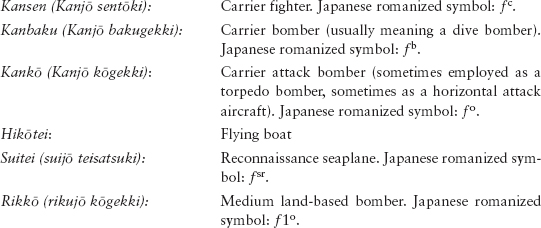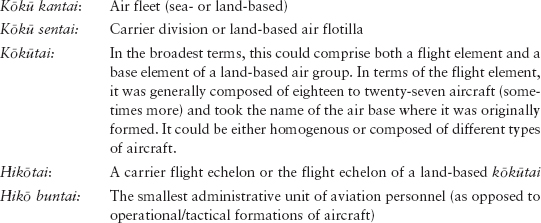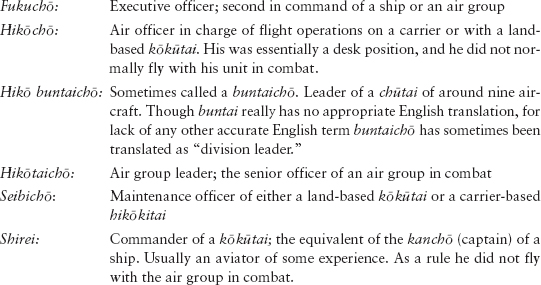
Glossary of Naval Aviation Terms
Information for this appendix was drawn from the following sources: Hata and Izawa, Japanese Naval Aces, xiii–xiv; Lundstrom, First Team: Pacific Naval Air Combat, 183–86; and consultation with Osamu Tagaya.
AIRCRAFT
Kansen (Kanjō sentōki): |
Carrier fighter. Japanese romanized symbol: fc. |
Kanbaku (Kanjō bakugekki): |
Carrier bomber (usually meaning a dive bomber). Japanese romanized symbol: fb. |
Kankō (Kanjō kōgekki): |
Carrier attack bomber (sometimes employed as a torpedo bomber, sometimes as a horizontal attack aircraft). Japanese romanized symbol: fo. |
Hikōtei: |
Flying boat |
Suitei (suijō teisatsuki): |
Reconnaissance seaplane. Japanese romanized symbol: fsr. |
Rikkō (rikujō kōgekki): |
Medium land-based bomber. Japanese romanized symbol: f1o. |

Kōkū kantai: |
Air fleet (sea- or land-based) |
Kōkū sentai: |
Carrier division or land-based air flotilla |
Kōkūtai: |
In the broadest terms, this could comprise both a flight element and a base element of a land-based air group. In terms of the flight element, it was generally composed of eighteen to twenty-seven aircraft (sometimes more) and took the name of the air base where it was originally formed. It could be either homogenous or composed of different types of aircraft. |
Hikōtai: |
A carrier flight echelon or the flight echelon of a land-based kōkūtai |
Hikō buntai: |
The smallest administrative unit of aviation personnel (as opposed to operational/tactical formations of aircraft) |

OPERATIONAL/TACTICAL FORMATIONS
Hikōkitai: |
A carrier aircraft echelon that took the name of the carrier on which it was embarked (and that was as much a part of the carrier’s complement as any of the crew) or the flight echelon of a land-based kōkūtai that took the name of the air base on which it was located |
Daitai: |
Eighteen to twenty-seven aircraft |
Chūtai: |
Nine aircraft |
Shōtai: |
Three aircraft |

AVIATION PERSONNEL
Fukuchō: |
Executive officer; second in command of a ship or an air group |
Hikōchō: |
Air officer in charge of flight operations on a carrier or with a land-based kōkūtai. His was essentially a desk position, and he did not normally fly with his unit in combat. |
Hikō buntaichō: |
Sometimes called a buntaichō. Leader of a chūtai of around nine aircraft. Though buntai really has no appropriate English translation, for lack of any other accurate English term buntaichō has sometimes been translated as “division leader.” |
Hikōtaichō: |
Air group leader; the senior officer of an air group in combat |
Seibichō: |
Maintenance officer of either a land-based kōkūtai or a carrier-based hikōkitai |
Shirei: |
Commander of a kōkūtai; the equivalent of the kanchō (captain) of a ship. Usually an aviator of some experience. As a rule he did not fly with the air group in combat. |
